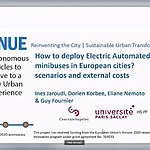An economic method to analyse these impacts is external costs. External costs analysis presents a way to quantify the implications of introducing AM within the transport system. They present indirect and uncompensated impacts, such as air pollution and congestion. This study focuses on potential future scenarios of AM in cities. It estimates the increase or decrease in external costs (comparing before and after introducing AM) as well as the effect on parking space. It provides insights into how AM could contribute to a sustainable transformation of cities. The study presents six potential scenarios focused on the potential modal shift caused by AM and their relation to public transport network and the associated external costs results. For instance, replacing all car trips in the city centre with AM services leads to the highest decrease in external costs, while replacing all diesel bus trips with AM causes an increase in externalities. Moreover, the results vary by the type of services offered and the area (urban or suburban) where the AM are introduced. This assessment provides policymakers with prescient methods to avoid disruptive innovations' drawbacks and utilise them to achieve sustainable urban development.
